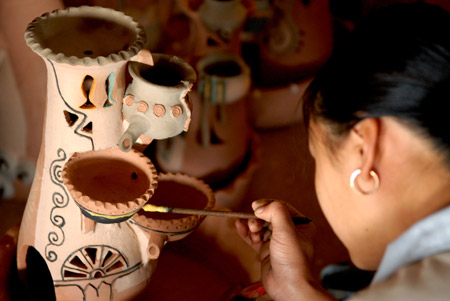Phu Lang Pottery
Phu Lang pottery village is a traditional craft village specializing in pottery production in Kinh Bac area, according to To Nguyen, Trinh Nguyen in Kinh Bac – Ha Bac book, Mr. Luu Phong Tu is founder of Phu Lang pottery village. At the end of Ly dynasty, he had been to China for a business trip, he had learned and back to the village to teach the people. Firstly, this profession was transferred to the residential areas on the banks of the Luc Dau river, then moved to the Van Kiep area (Hai Duong provinde). Around the beginning of the Tran dynasty (13th century) the profession was introduced to Phu Lang Trung, now Phu Land commune, Que Vo district, Bac Ninh province.

Illustrative photo
Currently, the Vietnam History Museum, still preserves and displays a number of Phu Lang pottery products dating from the 17th to 19th centuries. It is brown glazed ceramic products and its shades like eel skin glaze, yellowish, dark yellow, golden brown…
Phu Lang pottery focuses on three types: pottery used in befiefs such as: incense vases, radio worship, tripod…; Household ceramics: jars, vases, pots, pipes…; Decorative ceramics: vases, animal kettles, flower pots…
Phu Lang pottery is made from “bone” of red soil from the area of Thong Vat area, Cung Kiem (Bac Giang province). Through many stages, the clay is finely refined and then turntable shaped by the hand of the craftsman. The traditional producta of Phu Lang pottery are jars, pots, vases, crockery…
The prominent features in decoration of Phu Lang pottery is the use of embossing method in the form of intaglio, which the Phu Lang people call double in tagilo with themes: for gods, crane, “Tho” script, tiger-face seal, lotus leaf, water wave…
Phu Lang pottery has the advantage of natural colored, durable and strange enamel: shapes of pottery products are rustic, rough but strong and contains the primitive beauty of the soil and highlighted sculpture.
On January 19, 2016, Phu Lang pottery profession, Phu Lang commune, Que Vo district, Bac Ninh province was ranked National Intangible Cultural Herritage by the Ministry of Culture, Sports and Tourism.






